Integrated Characterization and Analysis of a Slow-Moving Landslide Using Geotechnical and Geophysical Methods
Abstract
1. Introduction
2. Materials and Methods
2.1. Characterization Tools
2.1.1. Total Station
2.1.2. Drilling and SPT
2.1.3. Electrical Resistivity Imaging (ERI)
2.1.4. Seismic Testing
2.1.5. Strength Testing
2.2. Slope Stability Analyses
3. Results
3.1. Integrated Characterization
3.2. Soil Properties
3.3. Model Calibration
3.4. Slope Stability Results
3.4.1. Analyses for an Initial Drained Failure
3.4.2. Analyses for an Initial Undrained Failure
3.4.3. Analyses for Residual Drained Strengths
4. Discussion and Conclusions
Author Contributions
Funding
Data Availability Statement
Acknowledgments
Conflicts of Interest
References
- Wright, S.G.; Zornberg, J.G.; Aguettant, J.E. The Fully Softened Shear Strength of High Plasticity Clays; Center for Transportation Research, University of Texas at Austin: Austin, TX, USA, 2007. [Google Scholar]
- Knights, M.J.; Montgomery, J.; Carcamo, P.S. Development of a Slope Failure Database for Alabama Highways. Bull. Eng. Geol. Environ. 2020, 79, 423–438. [Google Scholar] [CrossRef]
- Montgomery, J.; Kiernan, M.; Jackson, D.; McDonald, B. Integrating Surface-Based Geophysics into Landslide Investigations along Highways. In Proceedings of the Geo-Congress 2022, American Society of Civil Engineers, Charlotte, NC, USA, 17 March 2022; pp. 180–191. [Google Scholar] [CrossRef]
- Loke, M.H. Tutorial: 2-D and 3-D Electrical Imaging Surveys. Geotomo Software. 2021. Available online: https://www.researchgate.net/publication/264739285_Tutorial_2-D_and_3-D_Electrical_Imaging_Surveys (accessed on 21 September 2022).
- Perrone, A.; Lapenna, V.; Piscitelli, S. Electrical Resistivity Tomography Technique for Landslide Investigation: A Review. Earth-Sci. Rev. 2014, 135, 65–82. [Google Scholar] [CrossRef]
- Jongmans, D.; Garambois, S. Geophysical investigation of landslides: A Review. Bull. Soc. Géol. Fr. 2007, 178, 101–112. [Google Scholar] [CrossRef]
- Chae, B.-G.; Park, H.-J.; Catani, F.; Simoni, A.; Berti, M. Landslide Prediction, Monitoring and Early Warning: A Concise Review of State-of-the-Art. Geosci J. 2017, 21, 1033–1070. [Google Scholar] [CrossRef]
- Embankments, Dams, and Slopes Technical Committee; Stark, T.D.; Oommen, T.; Ning, Z.; Bouali, E.H.; Arasa, N.D.; Gregory, P.; Hughes, K.S.; Leshchinsky, B.; Praeg, R.; et al. Remote Sensing for Monitoring Embankments, Dams, and Slopes: Recent Advances; American Society of Civil Engineers: Reston, VA, USA, 2021; ISBN 978-0-7844-1572-6. [Google Scholar]
- Travelletti, J.; Malet, J.-P. Characterization of the 3D Geometry of Flow-like Landslides: A Methodology Based on the Integration of Heterogeneous Multi-Source Data. Eng. Geol. 2012, 128, 30–48. [Google Scholar] [CrossRef]
- Bunn, M.; Leshchinsky, B.; Olsen, M.J. Geologic Trends in Shear Strength Properties Inferred through Three-Dimensional Back Analysis of Landslide Inventories. J. Geophys. Res. Earth Surf. 2020, 125, e2019JF005461. [Google Scholar] [CrossRef]
- Donohue, S.; Long, M.; O’Connor, P.; Helle, T.E.; Pfaffhuber, A.; Rømoen, M. Geophysical Mapping of Quick Clay—A Case Study from Smørgrav, Norway. In Proceedings of the Near Surface 2009—15th EAGE European Meeting of Environmental and Engineering Geophysics, Dublin, Ireland, 7–9 September 2009; European Association of Geoscientists & Engineers: Dublin, Ireland, 2009. [Google Scholar] [CrossRef]
- Jongmans, D.; Bièvre, G.; Renalier, F.; Schwartz, S.; Beaurez, N.; Orengo, Y. Geophysical Investigation of a Large Landslide in Glaciolacustrine Clays in the Trièves Area (French Alps). Eng. Geol. 2009, 109, 45–56. [Google Scholar] [CrossRef]
- Huntley, D.; Bobrowsky, P.; Hendry, M.; Macciotta, R.; Best, M. Multi-Technique Geophysical Investigation of a Very Slow-Moving Landslide near Ashcroft, British Columbia, Canada. JEEG 2019, 24, 87–110. [Google Scholar] [CrossRef]
- Stark, T.D.; Vettel, J.J. Bromhead Ring Shear Test. Procedure. Geotech. Test. J. 1992, 15, 24–32. [Google Scholar] [CrossRef]
- ASTM D7608-18e1; Standard Test Method for Torsional Ring Shear Test to Measure Drained Fully Softened Shear Strength and Stress Dependent Strength Envelope of Fine-Grained Soils. ASTM International: West Conshohocken, PA, USA, 2018. [CrossRef]
- ASTM D6467-13e; Standard Test Method for Torsional Ring Shear Test to Determine Drained Residual Shear Strength of Fine-Grained Soils. ASTM International: West Conshohocken, PA, USA, 2018. [CrossRef]
- Skempton, A.W. First-time slides in over-consolidated clays. Géotechnique 1970, 20, 320–324. [Google Scholar] [CrossRef]
- Stark, T.D.; Eid, H.T. Slope Stability Analyses in Stiff Fissured Clays. J. Geotech. Geoenviron. Eng. 1997, 123, 335–343. [Google Scholar] [CrossRef]
- Xuan, M.; Montgomery, J.; Anderson, J.B. Examining the Effects of Suction and Nonlinear Strength Envelopes on the Stability of a High Plasticity Clay Slope. Geosciences 2021, 11, 449. [Google Scholar] [CrossRef]
- Baker, R. Nonlinear Mohr Envelopes Based on Triaxial Data. J. Geotech. Geoenviron. Eng. 2004, 130, 498–506. [Google Scholar] [CrossRef]
- Atkinson, J. Peak strength of overconsolidated clays. Géotechnique 2007, 57, 127–135. [Google Scholar] [CrossRef]
- VandenBerge, D.R.; Castellanos, B.A.; McGuire, M.P. Comparison and Use of Failure Envelope Forms for Slope Stability Analyses. Geotech. Geol. Eng. 2019, 37, 2029–2046. [Google Scholar] [CrossRef]
- Duncan, J.M.; Wright, S.G.; Brandon, T.L. Soil Strength and Slope Stability; John Wiley: Hoboken, NJ, USA, 2014. [Google Scholar]
- Dawson, E.M.; Roth, W.H.; Drescher, A. Slope Stability Analysis by Strength Reduction. Geotechnique 1999, 49, 835–840. [Google Scholar] [CrossRef]
- Perry, J. A Technique for Defining Nonlinear Shear Strength Envelopes, and Their Incorporation in a Slope Stability Method of Analysis. Q. J. Eng. Geol. Hydrogeol. 1994, 27, 231–241. [Google Scholar] [CrossRef]
- Jiang, J.-C.; Baker, R.; Yamagami, T. The Effect of Strength Envelope Nonlinearity on Slope Stability Computations. Can. Geotech. J. 2003, 40, 308–325. [Google Scholar] [CrossRef]
- VandenBerge, D.R.; McGuire, M.P. Practical Use of Modified Hoek–Brown Criterion for Soil Slope Stability Analysis. Geotech. Geol. Eng. 2019, 37, 5441–5455. [Google Scholar] [CrossRef]
- Sun, C.; Chai, J.; Luo, T.; Xu, Z.; Chen, X.; Qin, Y.; Ma, B. Nonlinear Shear-Strength Reduction Technique for Stability Analysis of Uniform Cohesive Slopes with a General Nonlinear Failure Criterion. Int. J. Geomech. 2021, 21, 06020033. [Google Scholar] [CrossRef]
- Hoek, E.; Carranza-Torres, C.; Corkum, B. Hoek-Brown Failure Criterion—2002 Edition. In Proceedings of the 5th North American Rock Mechanics and 17th Tunnelling Association of Canada Conference (NARMS-TAC), Toronto, ON, Canada, 7–10 July 2002; pp. 267–273. [Google Scholar]
- Sun, C.; Chai, J.; Luo, T.; Xu, Z.; Qin, Y.; Yuan, X.; Ma, B. Stability Charts for Pseudostatic Stability Analysis of Rock Slopes Using the Nonlinear Hoek–Brown Strength Reduction Technique. Adv. Civ. Eng. 2020, 2020, 8841090. [Google Scholar] [CrossRef]
- Sun, C.; Chai, J.; Xu, Z.; Qin, Y.; Chen, X. Stability Charts for Rock Mass Slopes Based on the Hoek-Brown Strength Reduction Technique. Eng. Geol. 2016, 214, 94–106. [Google Scholar] [CrossRef]
- Szabo, M.; Osborne, W.; Copeland, C., Jr.; Neathery, T. Geologic Map of Alabama (1:250,000): Alabama Geological Survey Special Map 220; Geological Survey of Alabama: Uscaloosa, AL, USA, 1988. [Google Scholar]
- Cook, M.; Baker, R.M.; Henderson, P.; McGregor, S.; Moss, N. Conecuh-Sepulga-Blackwater Rivers Watershed Protection Plan; Alabama Geologic Survey: Tuscaloosa, AL, USA, 2004. [Google Scholar]
- Nobahar, M.; Khan, M.S.; Stroud, M.; Amini, F.; Ivoke, J. Progressive Development of the Perched Water Zone in Highway Slopes Made of Highly Plastic Clay. Transp. Res. Rec. 2021, 2675, 715–728. [Google Scholar] [CrossRef]
- Khan, M.S.; Nobahar, M.; Stroud, M.; Ferguson, S.; Ivoke, J. Performance Evaluation of a Highway Slope on Expansive Soil in Mississippi. Int. J. Geomech. 2022, 22, 05021005. [Google Scholar] [CrossRef]
- Wathelet, M. Array Recordings of Ambient Vibrations: Surface-Wave Inversion. Ph.D. Thesis, Faculté des Sciences Appliquées, Liege University, Liege, Belgium, 2005. [Google Scholar]
- Wathelet, M. An Improved Neighborhood Algorithm: Parameter Conditions and Dynamic Scaling. Geophys. Res. Lett. 2008, 35, L09301. [Google Scholar] [CrossRef]
- Wathelet, M.; Chatelain, J.-L.; Cornou, C.; Giulio, G.D.; Guillier, B.; Ohrnberger, M.; Savvaidis, A. Geopsy: A User-Friendly Open-Source Tool Set for Ambient Vibration Processing. Seismol. Res. Lett. 2020, 91, 1878–1889. [Google Scholar] [CrossRef]
- Castellanos, B.A. Use and Measurement of Fully Softened Shear Strength. Ph.D. Thesis, Virginia Tech, Blacksburg, VA, USA, 2014. [Google Scholar]
- Stark, T.D. Spreadsheet for Drained Residual and Fully Softened Secant Friction Angles. 2022. Available online: https://tstark.net/wp-content/uploads/2012/10/Residual-FullySoftened-Correlations-2022-01-09-2022-LOCKED-Laboratory-2022.xlsx (accessed on 21 September 2022).
- Castellanos, B.A.; Ritchie, J.; Brandon, T.L. Estimating Fully Softened and Residual Shear Strength Parameters of Fine-Grained Soils; Center for Geotechnical Practice and Research, Virginia Tech: Blacksburg, VA, USA, 2021. [Google Scholar]
- Mesri, G.; Shahien, M. Residual Shear Strength Mobilized in First-Time Slope Failures. J. Geotech. Geoenviron. Eng. 2003, 129, 12–31. [Google Scholar] [CrossRef]
- Rocscience, Inc. Slide 2-2D Limit Equilibrium Analysis for Slopes, Version 9.013; Rocscience, Inc.: Toronto, ON, Canada, 2021.
- Itasca. FLAC, “Fast Lagrangian Analysis of Continua”, Version 8.0; Itasca Consulting Group: Minneapolis, MN, USA, 2016.
- Abu-Hassanein, Z.S.; Benson, C.H.; Blotz, L.R. Electrical Resistivity of Compacted Clays. J. Geotech. Eng. 1996, 122, 397–406. [Google Scholar] [CrossRef]
- Park, C.B.; Miller, R.D.; Xia, J. Multichannel Analysis of Surface Waves. Geophysics 1999, 64, 800–808. [Google Scholar] [CrossRef]
- Montgomery, J.; Jackson, D.; Kiernan, M.; Anderson, J.B. Use of Geophysical Methods for Sinkhole Exploration; ALDOT Report 930-945; Highway Research Center, Auburn University: Auburn, AL, USA, 2020. [Google Scholar]
- Mayne, P. Stress-Strain-Strength-Flow Parameters from Enhanced in-Situ Tests. In Proceedings of the International Conference on In-Situ Measurement of Soil Properties & Case Histories [In-Situ 2001], Bali, Indonesia, 21–24 May 2001; pp. 27–47. [Google Scholar]
- McVay, M.C.; Townsend, F.C.; Williams, R.C. Design of Socketed Drilled Shafts in Limestone. J. Geotech. Eng. 1992, 118, 1626–1637. [Google Scholar] [CrossRef]
- Gaviglio, P. Longitudinal Waves Propagation in a Limestone: The Relationship between Velocity and Density. Rock Mech. Rock Eng. 1989, 22, 299–306. [Google Scholar] [CrossRef]
- Yaşar, E.; Erdoğan, Y. Estimation of Rock Physicomechanical Properties Using Hardness Methods. Eng. Geol. 2004, 71, 281–288. [Google Scholar] [CrossRef]
- Bowles, J.E. Foundation Analysis and Design, 5th ed.; McGraw-Hill: Singapore, 1996. [Google Scholar]
- Kulhawy, F.H.; Mayne, P.W. Manual on Estimating Soil Properties for Foundation Design; Electric Power Research Inst.: Palo Alto, CA, USA; Cornell Univ.: Ithaca, NY, USA, 1990. [Google Scholar]
- Kiernan, M. Site Characterization and Modeling Considerations for Slopes Involving Fine Grained Strain-Softening Soils. Ph.D. Thesis, Auburn University, Auburn, AL, USA, 2021. [Google Scholar]
- Mesri, G. A Reevaluation of Su(Mob) = 0.22σ′p Using Laboratory Shear Tests. Can. Geotech. J. 1989, 26, 162–164. [Google Scholar] [CrossRef]
- Jamiolkowski, M.; Ladd, C.C.; Germaine, J.T.; Lancellotta, R. New Developments in Field and Laboratory Testing of Soils. In Proceedings of the 11th International Conference on Soil Mechanics and Foundation Engineering, San Francisco, CA, USA, 12–16 August 1985; pp. 57–153. [Google Scholar]
- D’Appolonia, E.; Alperstein, R.; D’Appolonia, D.J. Behavior of a Colluvial Slope. J. Soil Mech. Found. Div 1967, 93, 447–473. [Google Scholar] [CrossRef]
- Ramiah, B.K.; Purushothamaraj, P.; Tavane, N.G. Thixotropic Effects on Residual Strength of Remoulded Clays. Indian Geotech. J. 1973, 3, 189–197. [Google Scholar]
- Skempton, A.W. Residual strength of clays in landslides, folded strata and the Laboratory. Géotechnique 1985, 35, 3–18. [Google Scholar] [CrossRef]
- Stark, T.D.; Hussain, M. Shear Strength in Preexisting Landslides. J. Geotech. Geoenviron. Eng. 2010, 136, 957–962. [Google Scholar] [CrossRef]
- Cheng, Y.M.; Lansivaara, T.; Wei, W.B. Two-Dimensional Slope Stability Analysis by Limit Equilibrium and Strength Reduction Methods. Comput. Geotech. 2007, 34, 137–150. [Google Scholar] [CrossRef]
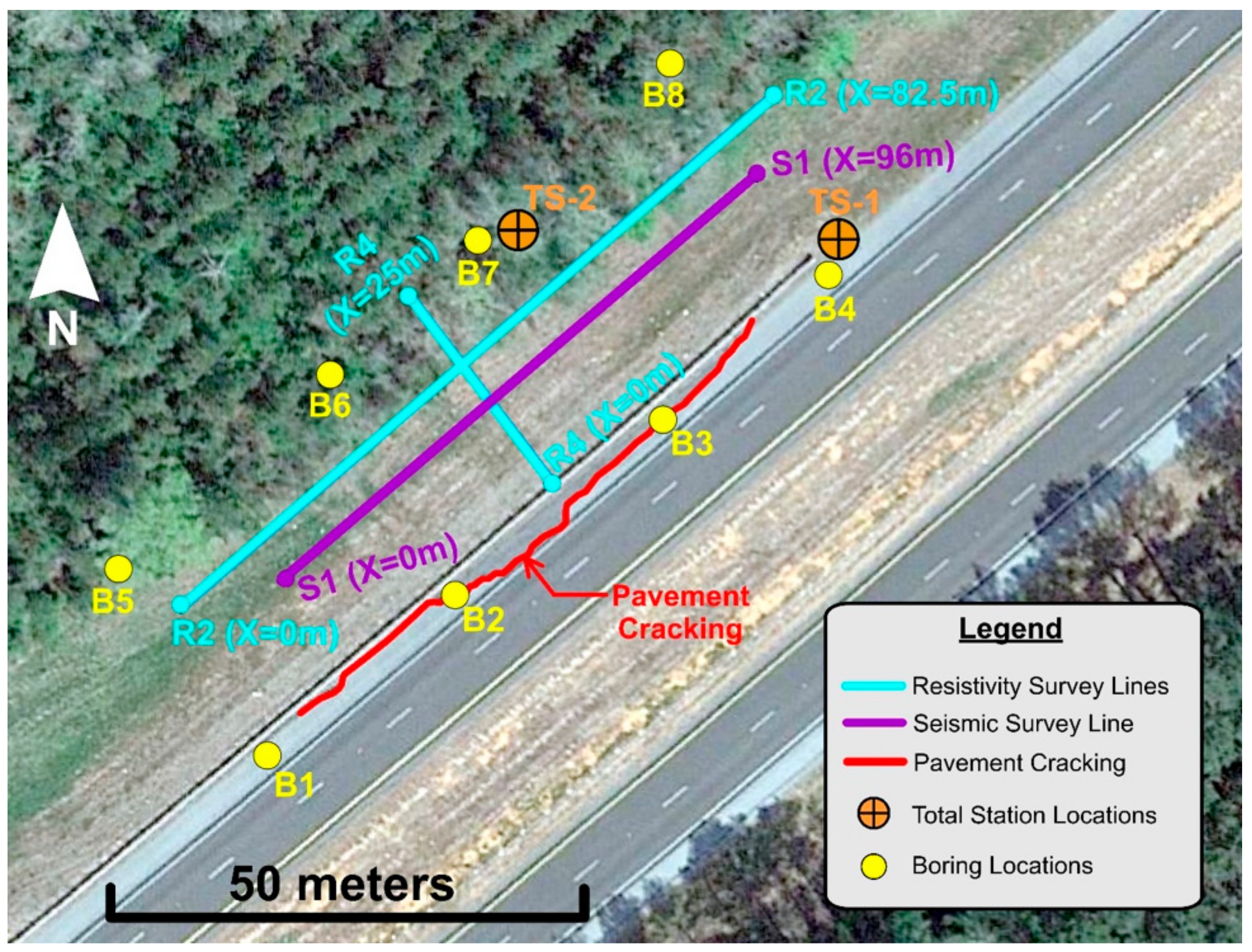

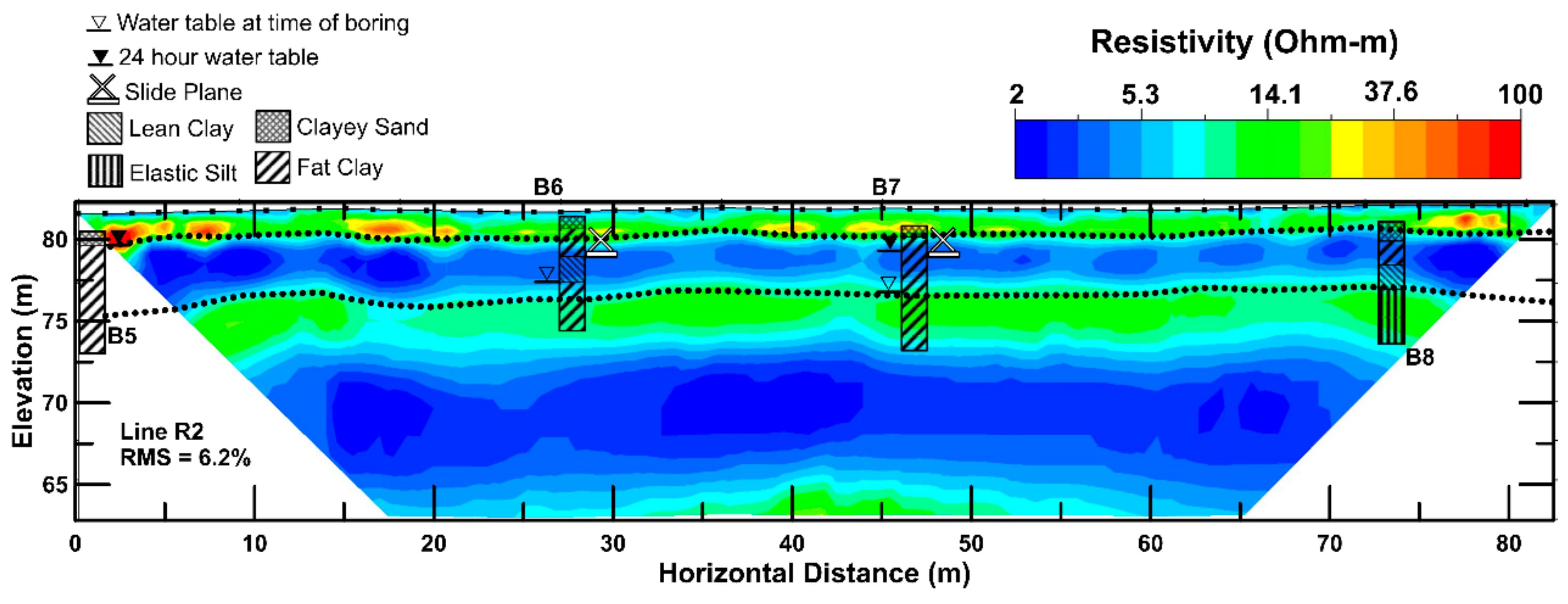
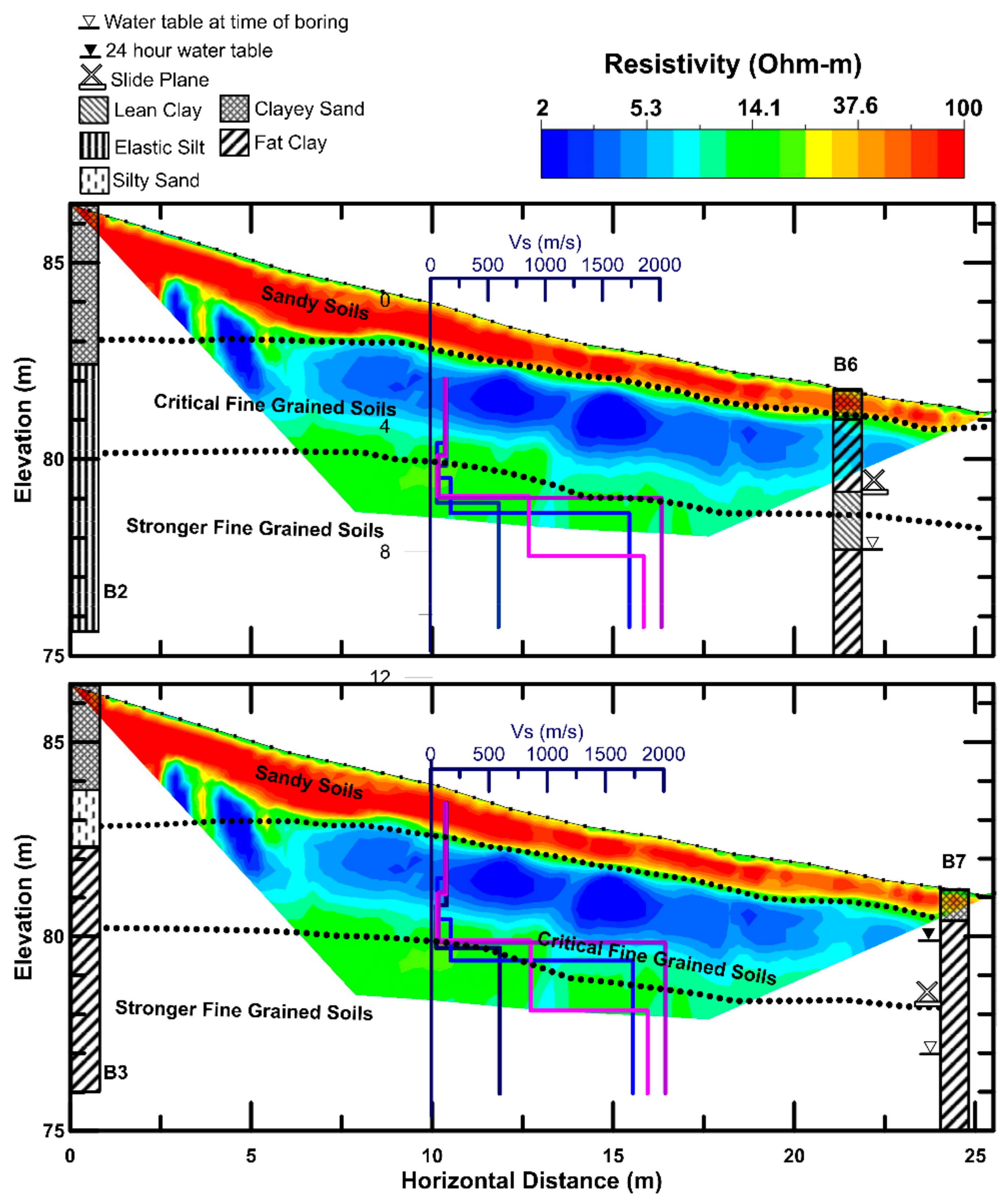
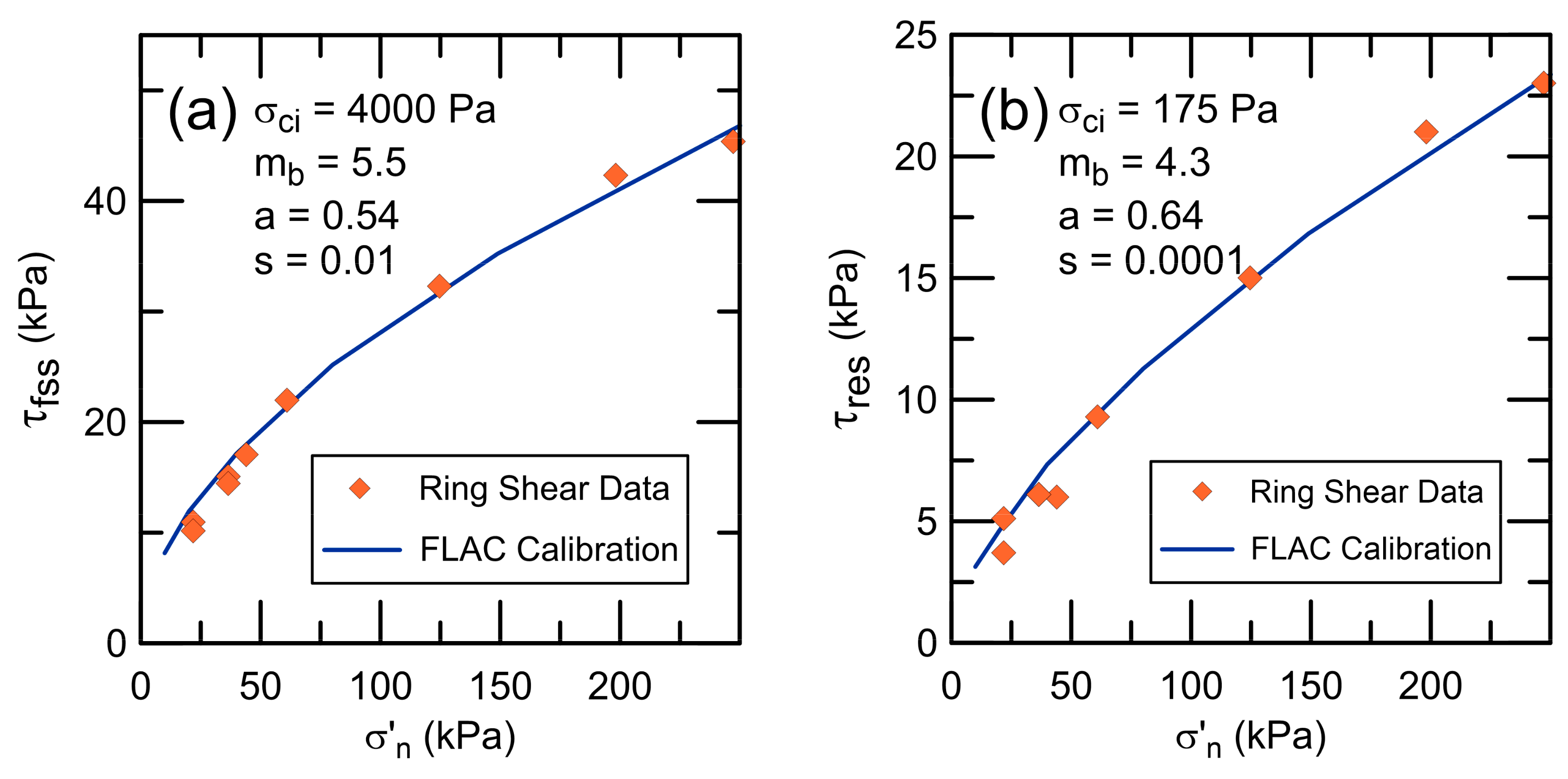
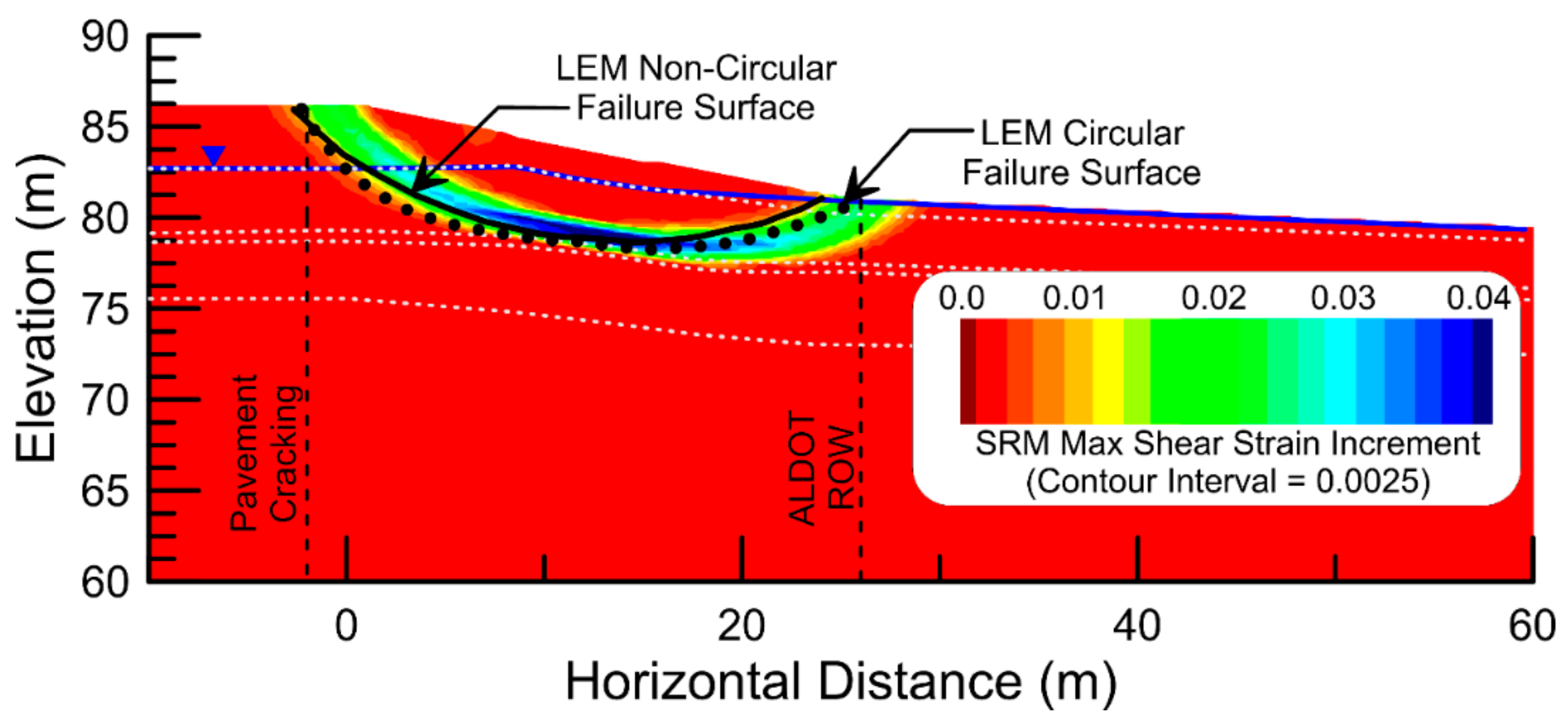
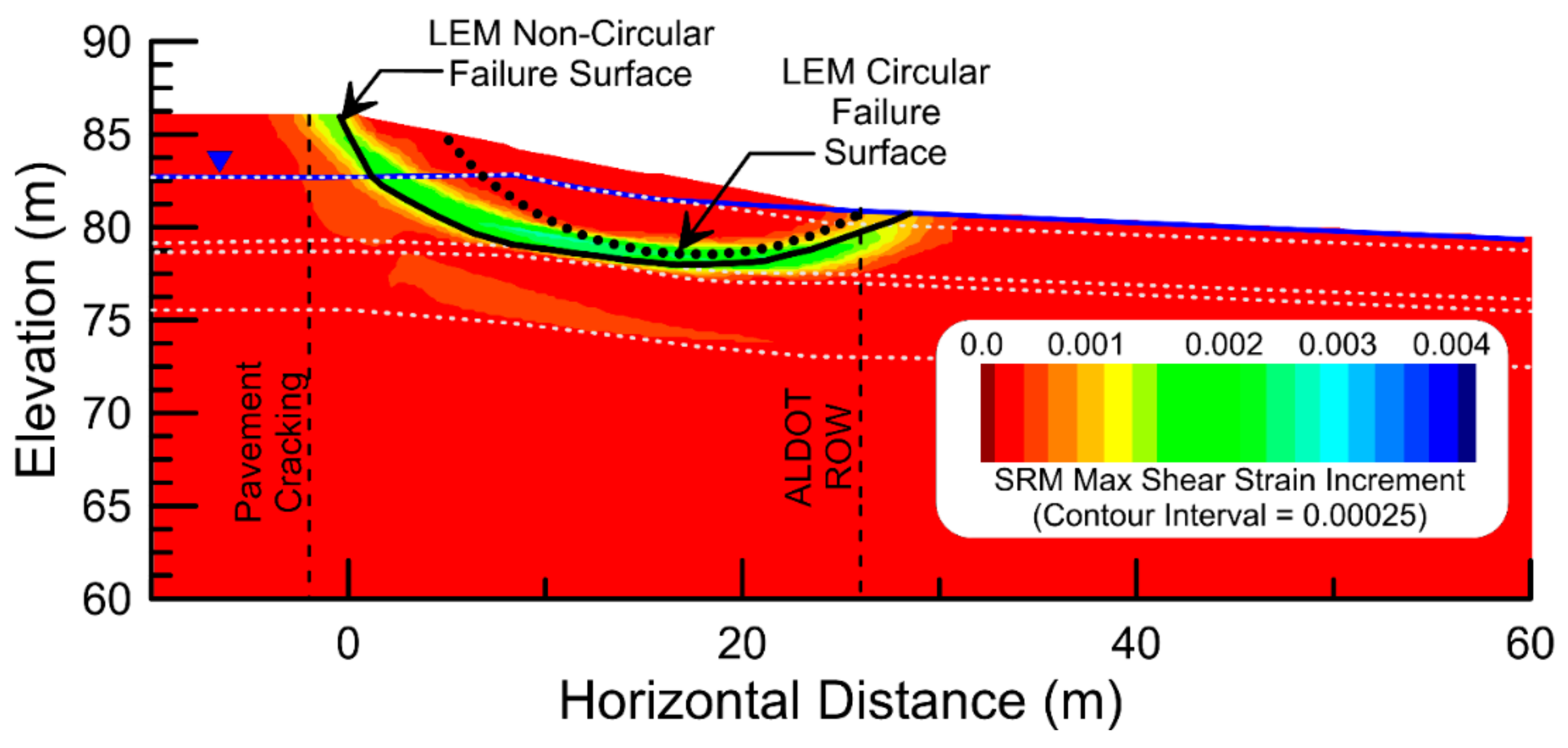
| Line | Date Performed | # Sensors | Sensor Spacing (m) | Line Length (m) | Downslope or Cross-Slope |
|---|---|---|---|---|---|
| R2 | 13 April 2021 | 56 | 1.5 | 82.5 | Cross-Slope |
| R4 | 26 May 2021 | 51 | 0.5 | 25 | Downslope |
| S1 | 13 April 2021 | 48 | 2.0 | 94 | Cross-Slope |
| Property | Clayey Sand | Clay | Limestone |
|---|---|---|---|
| VS (m/s) | 130 | 130 | 1700 |
| Unit Weight (kN/m3) | 20 | 16.7 | 25 |
| Drained Friction Angle (°) | 34 | - | - |
| Unconfined Compressive Strength (kPa) | - | - | 2300 |
| Fully Softened Drained Strength 1 | - | - | |
| Residual Drained Strength 1 | - | - | |
| Undrained Strength | - | - |
| Strength Condition | FS LEM: Circular | FS LEM: Noncircular | FS SRM |
|---|---|---|---|
| Fully Softened Drained | 1.57 | 1.49 | 1.42 |
| Peak Undrained | 0.97 | 0.91 | 1.02 |
| Residual Drained | 0.81 | 0.71 | 0.76 |
| Location | FS LEM: Noncircular (Baseline WT) | FS LEM: Noncircular (WT Lowered by 2 m) | ||
|---|---|---|---|---|
| a | b | |||
| Residual Strength | 0.47 | 0.71 | 0.71 | 0.88 |
| 20% Strength Recovery | 0.56 | 0.71 | 0.81 | 1.01 |
| 30% Strength Recovery | 0.62 | 0.71 | 0.88 | 1.10 |
| 40% Strength Recovery | 0.67 | 0.71 | 0.94 | 1.17 |
Publisher’s Note: MDPI stays neutral with regard to jurisdictional claims in published maps and institutional affiliations. |
© 2022 by the authors. Licensee MDPI, Basel, Switzerland. This article is an open access article distributed under the terms and conditions of the Creative Commons Attribution (CC BY) license (https://creativecommons.org/licenses/by/4.0/).
Share and Cite
Kiernan, M.; Xuan, M.; Montgomery, J.; Anderson, J.B. Integrated Characterization and Analysis of a Slow-Moving Landslide Using Geotechnical and Geophysical Methods. Geosciences 2022, 12, 404. https://doi.org/10.3390/geosciences12110404
Kiernan M, Xuan M, Montgomery J, Anderson JB. Integrated Characterization and Analysis of a Slow-Moving Landslide Using Geotechnical and Geophysical Methods. Geosciences. 2022; 12(11):404. https://doi.org/10.3390/geosciences12110404
Chicago/Turabian StyleKiernan, Michael, Mengwei Xuan, Jack Montgomery, and J. Brian Anderson. 2022. "Integrated Characterization and Analysis of a Slow-Moving Landslide Using Geotechnical and Geophysical Methods" Geosciences 12, no. 11: 404. https://doi.org/10.3390/geosciences12110404
APA StyleKiernan, M., Xuan, M., Montgomery, J., & Anderson, J. B. (2022). Integrated Characterization and Analysis of a Slow-Moving Landslide Using Geotechnical and Geophysical Methods. Geosciences, 12(11), 404. https://doi.org/10.3390/geosciences12110404









